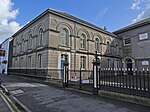Carmarthen Castle

Carmarthen Castle (Welsh: Castell Caerfyrddin) is a ruined castle in Carmarthen, West Wales, UK. First built by Walter, Sheriff of Gloucester in the early 1100s, the castle was captured and destroyed on several occasions before being rebuilt in stone during the 1190s. The castle was captured by Owain Glyndŵr in 1405. Henry VII's father died at Carmarthen Castle in 1456. During the Wars of the Roses the castle fell to William Herbert and, during the Civil War, was captured by Parliamentary forces. It was dismantled by order of Oliver Cromwell in the mid 1600s. It has been used as the site of Carmarthen's gaol until the 1920s. The remains of the castle were given a Grade I heritage listing in 1954 and is currently a tourist attraction and site of the town's Tourist Information Centre.
Excerpt from the Wikipedia article Carmarthen Castle (License: CC BY-SA 3.0, Authors, Images).Carmarthen Castle
Coracle Way,
Geographical coordinates (GPS) Address Nearby Places Show on map
Geographical coordinates (GPS)
| Latitude | Longitude |
|---|---|
| N 51.855 ° | E -4.306 ° |
Address
Coracle Way
Coracle Way
SA31 3JR , Carmarthen
Wales, United Kingdom
Open on Google Maps











